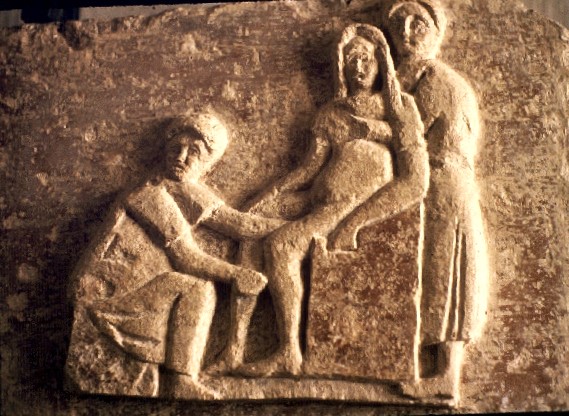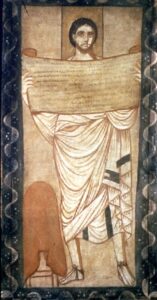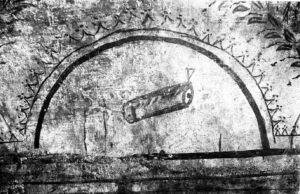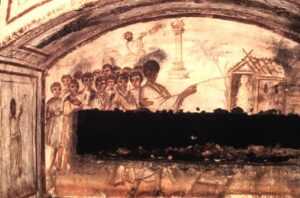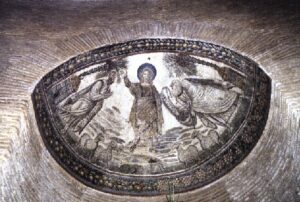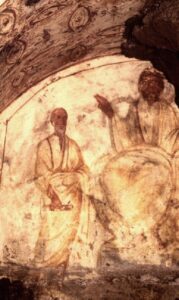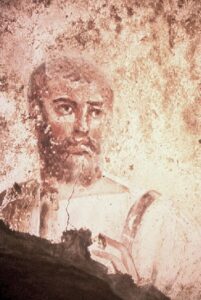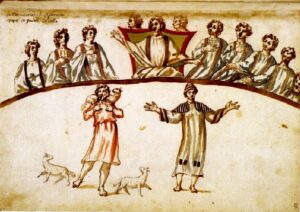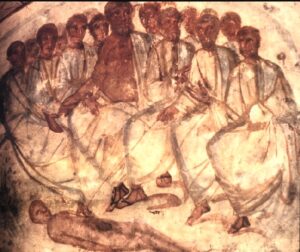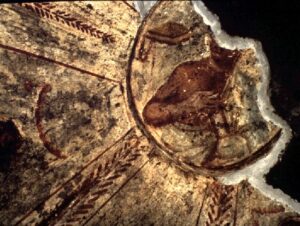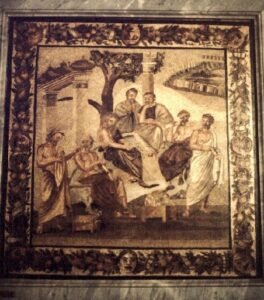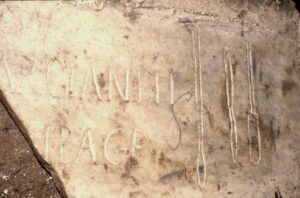Catacomb “Occupants”: Scrolls, Saints, and Scholars. Excerpt from: Estelle Shohet Brettman, Vaults of Memory: The Roman Jewish Catacombs and their Context in the Ancient Mediterranean World, with Amy K. Hirschfeld, Florence Wolsky, & Jessica Dello Russo. Boston: International Catacomb Society, 1991-2017 (rev. 2024).
Scrolls represented the law for both Jews and Christians, and the wisdom of philosophers and scholars for the pagan Greco-Roman world. Divine decrees and codes of law have an ancient history in the Near East, where an expressed desire to create a just and moral social order and sense of civic responsibility goes back at least to the late third millennium. Sumerian New Year's Day was a day of judgment by the Lagashite goddess concerned with ethics.[1]
Observing Jews living in the wisdom of the Torah, as well as faithful Christians living in Christ, could expect to share the joys of the afterlife with the Lord, surrounded by righteous followers and students who would perpetuate his teachings: "And I will put my spirit within you, and cause you to walk in my statutes, and ye shall keep my judgments, and do them" (Ezek. 36:27).
The Talmudic believer also has choices: "There are two ways before me; one leading to Gan Eden (Paradise), and the other to Gehinnom (Hell)."[2] With emphasis on the "two ways" of ethical behavior, the Treatise of the Two Ways, a Jewish Christian moralistic code for guidance in this world, states: "There are two ways in the world, over which are placed two angels, one of righteousness and the other of iniquity."[3] These teachings are part of the Didache, the earliest known record of "Church Orders," and are based on Jewish catechesis such as the biblical excerpts below. They reflect Jewish and Christian dualistic concepts of morality related to eternal life (good) and death (evil): "I have set before thee this day life and good, and death and evil" (Deut. 30:15); "For the Lord knoweth the way of the righteous: but the way of the ungodly shall perish" (Ps. 1:6); and the "way that leadeth to destruction" and the "way which leadeth unto life" (Matt. 7:13-14). Light (life) shall brighten the way of the virtuous and darkness (death) shall be the lot of the transgressor: "But the path of the just is as the shining light" and "The way of the wicked is as darkness" (Prov. 4:18-19) reflected in Paul's mission from Jesus to the Gentiles "to open their eyes, and to turn them from darkness to light, and from the power of Satan unto God that they may receive forgiveness of sins" (Acts 26:18).[4]
"Two ways" or two ethical choices imply reward and punishment. The Lord admonishes, "Behold, I set before you this day a blessing and a curse; A blessing if ye obey the commandments of the Lord your God...and a curse, if ye will not obey the commandments of the Lord your God" (Deut. 11:26-28). Chapters 12-30 of Deuteronomy are devoted to the "right way" for the Israelites, and the benefits to be derived from adhering to it.[5]
In the New Testament counterpart, abiding in Jesus who is "the way and the truth and the life," and thus keeping his commandments, is the only approach to God (John 15:4, 10; 14:6).[6] To the rebellious children of Israel, a forgiving Lord declares that they shall hear "a word... saying, this is the way, walk ye in it, when ye turn to the right hand, and when ye turn to the left..." and promises "rivers and streams of water" (Is. 30:21, 25).
Love of the Law, which is the very fiber of the fabric of Jewish life and has provided the continuity and cohesion of the Jews as a people over the millennia, is apparent in several of the epitaphs from the Jewish catacombs of Rome as well as in the imagery. As is read in Lev. 18:5: "keep statutes & live in them".[7] And in Sirach 24:1–34: "Yet again will I bring instruction to light as the morning, And will make these things shine forth afar off. Yet again will I pour forth doctrine as prophecy, and leave it for eternal generations."
The importance of the study or learning of the Law for ancient Jewry is attested to from its mention on the tombstone of Eusebius, a man appropriately named, Eusebius meaning pious. "Blessed is the man... his delight is in the Law of the Lord, and on his law he meditates day and night... In all that he does he prospers" (Ps. 1:1-3).
For the Early Church the Bible provided testimonia (prophetic passages) predicting that Jesus would come to fulfill the Law, thus offering deliverance and redemption--themes which are figured frequently in the art of the catacombs. Jesus said, teaching from the mountain: "Think not that I am come to destroy the law or the prophets: I am not come to destroy, but to fulfill" (Mt. 5:17). "And he said unto them, these are the words which I spake unto you while I was yet with you, that all things must be fulfilled which were in the law of Moses, and in the prophets, and in the psalms concerning me" (Luke 24:27, 44).
Idealized renditions of Greek philosophers and sages were prototypes for the depiction of Jesus and the apostles in Christian art. Jesus was presented as "Teacher of the True Philosophy," and in the form of Asclepius, as well as other Greco-Roman deities portrayed in an attitude of imperial majesty.
Fig. 1. A Covenant with God and its Promise: Attired in a draped, fringed Greek tunic (chiton), with vertical stripes denoting rank in the Roman world (clavi), and, a Greek outer garment (himation), an imposing Ezra or, possibly, Moses looks up from his reading of a Torah scroll, thickly rolled at each end around a rod or "pillar." Curiously, the writing is on the exterior side of the parchment, the repository of which must be the veiled object in the shape of the Ark of the Covenant on his right (Exod. 25:21). West wall painting. Dura Europos Synagogue (244-245).[8]
Fig. 2. Torah Scroll. The knob, the umbilicus of the rod and the titulus (tab for identification) are both in evidence. Vault painting, east arcosolium. Frescoed cubiculum, upper catacomb of Villa Torlonia. "Forever, O Lord, thy word is settled in heaven" (Ps. 119:89). The grass withereth, the flower fadeth: but the word of our God shall stand for ever (Isa. 40:8).

Fig. 3. Detail of a marble inscription from the Catacomb of Monteverde, Rome (Frey #333, Noy #68). In Greek: "Here lies Eusebius, the teacher, student of the Law, with his wife. Peace…." (DAPICS n. 3351).
Fig. 3. A Teacher of the Law. "Here lies Eusebius, the teacher, learned in the law, with his wife. Peace." According to some scholars, the Greek word meaning peace, eirene, could be interpreted as Irene, possibly the name of Eusebius' wife; other scholars claim that the word peace was used alone because no space remained for the rest of the common epithet "in peace his sleep." The marble tombstone is from the Monteverde catacomb.
Fig. 4. The Law and Deliverance. Atop the mountain (Sinai) veiled in clouds, in a conflation of biblical episodes, Moses receives the Law from the hand of God before the pillar of fire, the guiding light of the Lord by night for the wandering children of Israel (Exod. 13:21-22). In the foreground below, with his rod Jesus raises Lazarus from the dead. "He comes forth" here in the entrance of a shrine-like building (John 11:43-44). Lunette painting. Left arcosolium. Cubiculum O, Catacomb of via Dino Compagni, Rome. In the fresco on the left wall of the arcosolium, a person who might be a prophet points to a symbolic star. His left hand grasps the folds of his robe and may be holding a scroll.
Fig. 5. Traditio Legis. Under a star a nimbed Jesus, shown in majestic imperial stance in the company of his flock, gives to the apostle Peter the scroll of the Law, representing the Church. Paul looks on in a lush Paradise framed with garlands of the fruits of the earth and flanked by two palm trees growing behind small buildings, perhaps representing the gates of Paradise. Restored mosaic. North apse of the ambulatory of Sta. Costanza. About the first half of the 4th century CE.
Fig. 6. Jesus Instructs the Apostles Peter and Paul. Jesus with halo is enthroned between Paul and Peter. Both Peter and the left hand of Jesus holding a scroll are obscured now by an intrusive cement building pier. The apostles hold scrolls in their right hands. Lunette painting, left arcosolium. Sala I, Catacomb of via Dino Compagni, Rome. Jesus became the new law for the faithful: "For the law of the Spirit of life in Christ Jesus hath made me free from the law of sin and death" (Rom. 8: 2).
Fig. 7. (DAPICS nn. 0182, 1112.) Portrait of a Philosopher(?). A sensitive depiction of a figure in the tradition of the Greek philosopher. Mid-3rd century wall painting. Cubiculum III, hypogeum of the Aurelii, Rome.
Fig. 8. Jesus the Teacher Enthroned among the Apostles. Lunette painting, arcosolium of the Apostles near the cubiculum of Ampliatus, catacomb of Domitilla, Rome.
Fig. 9. A Sixteenth Century View of the Same. Chacon's illustrator created his own version of this Domitilla fresco of Jesus among the Apostles by adding the quintessential Christian symbols, the Good Shepherd and an orans.
Fig. 10. The Archetypal Healer. Wearing Greek philosopher's robes, Asclepius clutches in his left hand a scroll and his staff encircled by a serpent. He appears about to receive the offering of a cock from a page. The scene brings to mind Socrates' request to Crito to offer a cock to the god of medicine upon his death. The ancient Greeks regarded the cock as a chthonic symbol connected with the concept that death was a remedy for evil. Statue in a room facing the lacus, square basin, in the sacred shrine of the nymph Juturna, the keeper of salubrious waters. Located in the Roman Forum. The healing quality of the staff with coiled serpent was evocative of the biblical saving instrument which cured the wayward "children of Israel" who had been punished by the bites of "fiery serpents": "And the Lord said unto Moses: Make thee a fiery serpent, and set it on a pole, and it shall come to pass, that every one that is bitten, when he looketh upon it, shall live" (Num. 21: 8).
Fig. 11. Physician-Saint. A frescoed pillar depicts a Christian healer, Saint Luke holding a scroll in his right hand~ a pouch for surgical instruments is suspended from his left. The inscription below dates this painting to the seventh century reign of Emperor Constantine IV. The subterranean basilica of SS. Felice e Adautto, Catacomb of Commodilla, Rome.
Fig. 12. Lesson in Anatomy. In this early visual record of a lesson in anatomy, the teaching doctor surrounded by his "disciples" may represent the deceased practicing his profession or may be a symbolic scene. He wears the traditional exomis tunic of a philosopher. The apparent prosector demonstrates with his wand-like pointer while the subject of the anatomy lesson appears to be very much aware of the proceedings. The composition bears a strong resemblance to the fresco in Domitilla in which Jesus is depicted as the Teacher. Lunette painting, right arcosolium. Sala I in the Catacomb of Via Dino Compagni, Rome. Philosophers in antiquity taught the arts and sciences; men of medicine like Galen and Sextus Empiricus were also interested in philosophy.[9]
Fig. 13. A Circle of "Scholars on High". Savants, perhaps venerated antecedents of the deceased, alternate on occasion with baskets of scrolls in wedge shaped sections divided by palm branches. Vault painting. Sala I in which the physician and his students are also depicted. Catacomb of Via Dino Compagni, Rome.
Jewish aspirations for the afterlife included participation in an "Academy on High" with the Lord who presided over the instruction and learned discussions. Pious scholars and students of the Torah who sat in a half circle like the Sanhedrin. When a sage was called to the "Academy on High," it alluded to his death. (3.3 BM (Bava Mezia) 86a.)
Fig. 14. The Seven Sages. Amid Athenian landmarks, six sages look on as a seventh points to a globe on a bench. The seven famous Greek sages of antiquity taught in the traditions of Plato and Aristotle. Their assembly served as a prototype for teaching scenes. The philosophers normally portrayed were Thales, Solon, Bias, Chilon, Cleobulus, Pittacus, and Periander. Sometimes Socrates joined their company. Mosaic from Pompeii, now in the National Archaeological Museum of Naples.
Fig. 15. Bodily Concerns. In a parody of the seven sages, these "sette sapienti" discuss with typical Roman earthiness the ills of the digestive tract and how to cure them. In Roman fashion, the elegance of the script and the painting is in marked contrast to the crude wit. Remains of paintings from a popina, a pub-type of eating and drinking place. Now part of the apodyterium (dressing room) of the Terme dei Sette Sapienti (Baths of the Seven Sages) at Ostia Antica. Perhaps of the early 1st century.[10]
Fig. 16. Beauty and a Scholar? Here an elegant lady bears the attribute of a scholar. The Romans considered it fashionable to be depicted, in this manner, with scroll or tabula in hand. Lower vault painting, left arcosolium. In the region of the cubiculum of Nicerus, catacomb of ss. Marcellino e Pietro, Rome.
Fig. 17. A Surgeon's Legacy. A wordless tombstone carved only with medical instruments reveals the profession of the deceased. Originally from the catacomb of Pretestato, Rome.[11]
Fig. 18. A Woman's Career in Ancient Rome. "Marciana ... in peace." The tools of her calling suggest that Marciana was a midwife (obstetrix). catacomb of Domitilla, Rome.
Fig. 19. Birth of a Baby. A midwife assists in the delivery of a child. Terracotta relief from the tomb of M. Ulpius Merimnus in Isola Sacra, the ancient cemetery of the Port of Rome.
Fig. 20. A Physician in his Study. Scrolls and the tools of his trade are depicted on the shelves of a cabinet carved on the front of the sarcophagus. The chests used at this time resembled the receptacles for the scrolls of the Torah. physician who tended a practice in Portus, close to Ostia. The inscription on the upper and side borders, which frame his portrait, cites the traditional penalty for disturbers of tombs and invokes a curse for eternal punishment upon the offenders.
Fig. 21. Carved on a Roman sarcophagus, Jesus separates the sheep (the righteous and blessed) who will enjoy "life eternal" from the goats (the uncaring and cursed) who "shall go away into everlasting punishment". Metropolitan Museum of Art, Rogers Fund, 1924.
Those who are in Christ Jesus" and who "walk not after the flesh [or selfish interests] but after the Spirit [of God] and are spiritually minded will enjoy "life and peace, while "to be carnally minded is death" (Rom. 8:1, 6--see also Gal. 5:16; 6:8). Again, in Paul's teachings "A man is justified [through redemption that is in Jesus] by faith [in Jesus] without the deeds of the law" (Rom. 3:28 and also Gal. 2:16). And in a direct correlation with vegetation and its need for water, the faithful follower of the Lord will thrive like "a tree planted by waters", whereas the impious "shall inhabit the parched places in the wilderness" (Jer. 17:5-8). In the same vein, to the faithful devotee who keeps his commandments the Lord promises that he "will give rain in due season, and the land shall yield her increase, and the trees of the field shall yield their fruit" (Lev. 26:3-4). The ruler of Israel who can discern justice from injustice will also be rewarded: "Thou lovest righteousness and hatest wickedness: therefore, God, thy God, hath anointed thee with the oil of gladness... (Ps. 45:7); just as Jesus is described in Heb. 1:8-9. In an earlier parallel from the Coffin Texts, the deceased Egyptian describes the "great judge" (the Sun-god): "He loves righteousness and hates evil, upon his favorite ways of righteousness whereon the gods lead."[12] In guiding instructions to his children included in a poem on his mortuary stele, an official of King Amenemhet III, affirms punishment for transgressors of the will of the divine pharaoh, and creation and abundance for those who "tread his path."[13]
[1] Samuel N. Kramer, The Sumerians (Chicago: University of Chicago Press, 1963), p. 124.
[2] Babylonian Talmud, Berakhot, 28 B.
[3] Jean Danielou, The Theology of Jewish Christianity (Chicago: Regnery, 1964), p. 142.
[4] Allusions to light as the equivalent of life and darkness as the symbol of death are expressed in Job 38:19-20: "Where is the way where light dwelleth? and as for darkness, where is the place thereof...that thou shouldest know the paths to the house thereof?" The followers of Jesus "shall not walk in darkness, but shall have the light of life (John 8:12).
[5] Like Leviticus 17-26, they are an expansion of the original Decalogue and ordinances of the Covenant (the latter adapted from existing Near Eastern agricultural laws) set forth in Exodus 20-23.
[6] The Sermon on the Mount is the code of conduct for Christianity (Matt. 5:3-7:27) as is a briefer segment in Luke (6:20-39) which is based on Matthew's Gospel.
[7] From Sirach (first under H20): E. R. Goodenough, Jewish Symbols of the Greco-Roman Period, v. 6 (New York: Pantheon, 1958), p.194.
[8] Carl Kraeling, Excavations at Dura-Europos, Final Report Volume VIII, Part 1 The Synagogue (New Haven: Yale University Press, 1956), pp. 232-235, 239, concluded that the majestic figure represented Ezra, the revered first Scribal scholar, perhaps reading from his own scroll of the Law which was to become the prototype for the script employed in later.
[9] An anatomist who dissects for teaching purposes. The author is grateful to Dr. Mark D. Altschule, M.D., Honorary Curator of Prints and Photographic Material, Countway Library of Medicine, Harvard Medical School, for his advice with this material. Dr. Altschule observes that an example for this kind of medical practice might have been set many centuries earlier by Herophilus in the 3rd century B.C.E. This noted Alexandrian was one of the physicians who was accused of dissecting living criminals by Celsus, who wrote a rare Latin treatise on 1st century medicine. Tertullian, the early church father, later wrote of him that "he hated mankind for the sake of knowledge."
[10] Russell Meiggs, Roman Ostia (Oxford: Clarendon Press, 1973), p. 429 and plate XXIX.
[11] Curiously, a fragment of a sarcophagus with the Greek epitaph of Aul(o?)s Bedis, a chief medical officer, was found near the entrance of the catacomb of Randanini which neighbors on the catacombs of Pretestato. Frey felt that it was a pagan inscription, since there were probably non-Jewish burials above this cemetery: Corpus Inscriptionum Judaicarum 1 (Vatican City: Pontificio Istituto di Archeologia Cristiana, 1936), pp. 535-536.
[12] James Breasted, Development of Religion and Thought in Ancient Egypt (New York, Charles Scribner’s Sons, 1912), pp. 253-254.
[13] Dynasty XII, Middle Kingdom. From James Breasted, Ancient Records of Egypt: Historical Documents from the Earliest Times to the Persian Conquest (New York: Charles Scribner’s Sons, 1906), p. 327f., no. 747.
